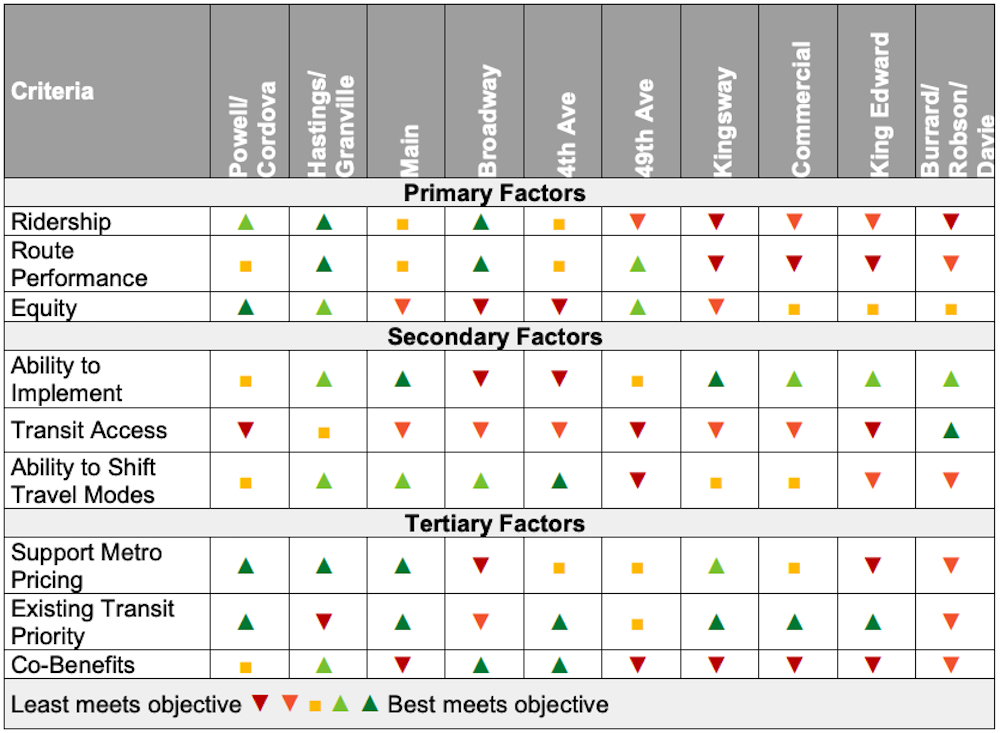City of Vancouver planning to speed up TransLink buses on 10 major street corridors

As many as 10 major arterial street corridors that are heavily used by TransLink bus services, but experience congestion and delays, could see bus priority measures at some point over the span of this decade.
The City of Vancouver plans to work with the public transit authority to develop new strategies that help speed up and improve the reliability of bus services.
- See also:
Bus priority measures include the practice of “bus stop balancing” of removing bus stops where they are too closely spaced, building bus bulges and boarding islands on the curbside lane so that buses do not have to pull into and out of a stop, implementing bus-only lanes and queue jumpers, adding left-turn regulations and right-turn lanes, and introducing transit signal priority that advances buses at major intersections.
This is one of the numerous strategies in the Climate Emergency Action Plan (CEAP), approved by city council earlier in November.
There will be some funding to support the first of these bus priority measures over the short term, with the newly released draft 2021 budget calling for $100,000 to support city staff’s early planning costs of determining the priority corridor project in the first quarter of 2021. Between the second quarter of 2021 and the second quarter of 2022, there will be detailed planning, engagement, and design.
Then in 2022, about $1.2 million will be set aside to proceed with the construction of “one significant bus priority corridor or equivalent” by the end of that year.
A total of 10 bus priority corridor projects have been identified for the city to reduce the severe delays that are currently experienced.
There are six short- to medium-term corridor projects by 2025, including:
1. Hastings Street and Granville Street corridors (between Hastings Park and Granville Street along Hastings Street, and between Hastings Street and the north end of the Granville Bridge along Granville Street),
2. Powell Street and Cordova Street (between Main Street and Nanaimo Street)
3. West Broadway (between Alma Street and Arbutus Street)
4. Main Street (between Hastings Street and Terminal Avenue, and between Kingsway and Southeast Marine Drive)
5. 49th Avenue (between Main Street and Southwest Marine Drive)
6. West 4th Avenue (between Alma Street and Burrard Street)
Another four corridor projects are over the longer term, slated for completion between 2026 and 2030:
7. Kingsway (between Fraser Street and Boundary Road
8. Commercial Drive (between East 12th Avenue and Hastings Street)
9. King Edward Avenue, Nanaimo Street, and East 22nd Avenue (between Blanca Street and Boundary Road)
10. Burrard Street/Robson Street/Davie Street corridors (within downtown Vancouver)

City of Vancouver Bus Speed and Reliability Corridors, 2021-2030. (City of Vancouver)

City of Vancouver Bus Speed and Reliability Corridors, 2021-2030. (City of Vancouver)

City of Vancouver Bus Speed and Reliability Corridors, 2021-2030. Click on the image for an enlarged version. (City of Vancouver)
Future detailed planning will determine exactly what kind of bus priority measures will be put in place for each of these corridors, with bus-only lanes — full-time or part-time/peak hour — being the most intensive of the options to help reduce travel times.
All of this is in addition to three bus-only lane projects borne from the COVID-19 response directly spearheaded by TransLink in partnership with the municipal government. Before the end of 2020, bus-only lanes will be rolled out for stretches of:
- Main Street and Kingsway (between Hastings Street and Terminal Avenue along Main Street, and between Main Street and Fraser Street along Kingsway)
- Granville Street (between 16th Avenue and Southwest Marine Drive)
- 49th Avenue (between Main Street and Boundary Road)
Bus bulges have also been installed at select bus stops on Robson Street.
These bus priority measures are in addition to the changes made to 41st Avenue and Joyce Street in 2019 for the R4 RapidBus between UBC and SkyTrain’s Joyce-Collingwood Station, which launched early this year.
The municipal government expects there will be continued funding from TransLink for new bus priority measures, but it has also determined a need to provide supplemental city funding as part of the $500-million CEAP agenda to fully rollout the list of corridors slated for bus priority measures over 10 years.
There are over 30 strategies under CEAP, including Metro Core mobility pricing (road tolls entering downtown Vancouver and Central Broadway), citywide mandatory residential street parking permits, the expansion of electric-battery vehicle charging stations, and various green building initiatives and requirements.

